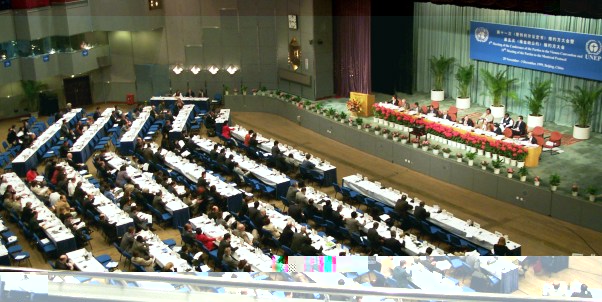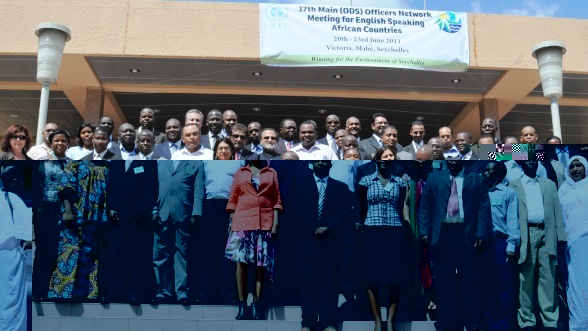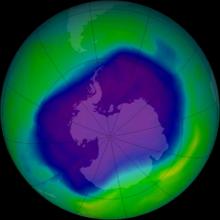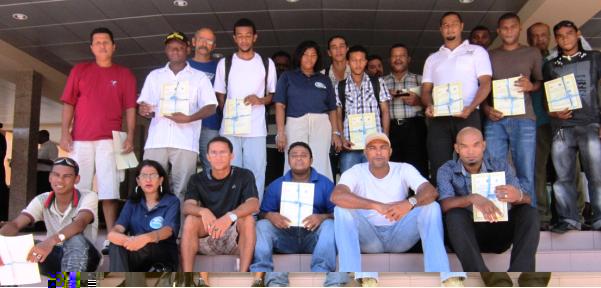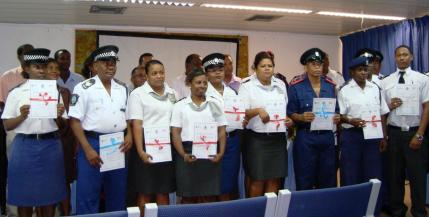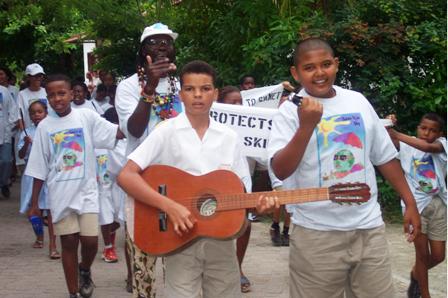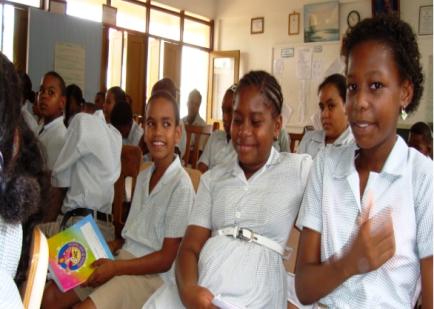Protecting our atmosphere for generations to come-25 years of the Montreal Protocol |15 September 2012
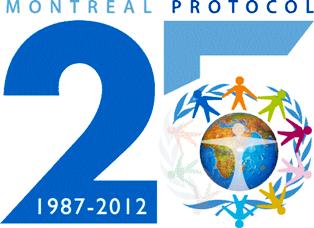
We can only speculate, but saving the ozone layer will surely be among those they will 
Evidence that human activities affect the ozone layer in the stratosphere which is 10-50 km above the surface has been building up over the last 25 years, ever since scientists first suggested in 1970 that the release in the atmosphere of chlorofluorocarbons (CFCs), hydrochlorofluorocarbon (HCFCs), methyl bromide and others could reduce the amount of ozone over our heads. The breakdown of these gases was detected in the stratosphere which acts as a shield preventing harmful UV radiation from reaching earth. When the ozone hole was detected, it was soon linked to this increase in these chlorine compounds.
The loss of ozone was not restricted to the Antarctic – at around the same time the first firm evidence was produced that there had been an ozone decrease over the heavily populated northern mid-latitudes (30-60⁰N). However, unlike the sudden and near total loss of ozone over Antarctica at certain altitudes, the loss of ozone in mid-latitudes is much less and much slower – only a few percentage points per year. However, it is a very worrying trend and which is the subject of intense scientific research at present. On September 14, 1987, delegates from 43 countries around the world concerned about the depletion of the ozone layer met to discuss threats of the thinning ozone layer. This was a landmark agreement that identifies the major ozone depleting substances (ODS) and established a timetable for reduction and eventual elimination of the production and consumption world-wide.
The eleventh meeting of the parties to the Montreal Protocol on substances that deplete the ozone layer and the fifth conference of the parties to the Vienna convention for the protection of the ozone layer met jointly in Beijing, China, from November 29 to December 3, 1999. Over 700 delegates attended the meeting, which aimed to agree on further funding and additional steps to help reduce the consumption and production of ozone-depleting substances.
Hopes of ozone layer recovery
As we mark the 25th anniversary of the Montreal Protocol, the once endangered ozone layer is recovering. It is expected to return to pre-1980 levels by mid-century, assuming all countries continue to meet their compliance commitments.
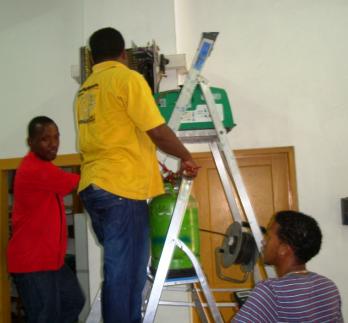
It was possible thanks to the passion, dedication and hard work of thousands of individuals in government, the private sector, academic, and civil society. Their efforts have literally helped save the protective ozone shield on our sky – and prevented millions of cases of skin cancer and cataracts and it also has made a significant contribution in halting climate change.
In a quarter century of successful implementation, the protocol has been continuously strengthened to cover the phase-out of nearly 100 ozone depleting substances.
It is the world’s most widely ratified treaty, with 197 signatories. Its multilateral fund has enabled an unprecedented transfer of ozone-friendly technologies to developing countries helped by a powerful network of well-trained national ozone officers in every country of the world. This unique on-the-ground asset has been critical for ensuring that the Montreal Protocol has delivered on its promises.
The protocol is widely hailed as a classic case of science-based policy making and action to protect a global commons. The officials, diplomats, corporate leaders and others who negotiated it built on cutting edge science. The protocol is widely recognised as a success story which has put the ozone layer on the road to recovery. The protocol has also already helped significantly to protect the global climate since ozone depleting substances are also potent greenhouse gases. The protocol’s accomplishments on both fronts show that worldwide consensus on important environmental issues is within reach. This is an important message that gives us hope for tackling many difficult environmental problems.
During the CFC phase-out, 103 countries were classified as Low Volume Consuming (LVCs) countries –those consuming less than 360 tonnes of ODS including Seychelles are seen to have made a substantial contribution to this global effort. Although they were non-producers and their collective emissions impacted the ozone layer far less, LVCs took many actions to replace ODS as did all other Article 5 countries.
The total volume of ODS phased out from the LVCs may seem relatively small. However, LVCs have accounted for phasing out approximately 7,742 tonnes of ODS, approximately 4.7% of the total ODS phased out by Article 5 countries.
This success of the Montreal Protocol can be attributed to many factors:
• The political commitment of respective governments:
These actions have provided invaluable support mechanisms and created an enabling environment mainly through fully operational licensing system to drive the initiatives on the Montreal Protocol.
• Financial cooperation:
Setting up the multilateral fund in 1990 and the strategic financing of Institutional Strengthening Projects (ISP) in LVCs were crucial for sustaining momentum in phase-out.
The ISP was the single most important arrangement that allowed LVCs to meet their obligations.
• Technical cooperation:
Research by assessment panels and technical support from implementing agencies through technological options, provided the knowledge and skills base to LVCs on appropriate choices.
• Education and awareness:
The awareness raising initiatives provided all stakeholders with accurate and latest information.
• Participatory governance:
The involvement of LVCs in the negotiation processes at the executive committee meetings and in the meetings of the parties enabled sound decisions and policies for LVCs.
The 25th anniversary of the Montreal Protocol is an occasion to celebrate the collective efforts of the international community to save the planet from human destruction.
The Montreal Protocol – first signed on the September 16, 1987 – has achieved much in 25 years, but still faces challenges, though it was successful in avoiding further deterioration of the ozone layer and established the foundations for its recovery, mainly because all parties support and cooperate with each other adhering to a consistent spirit of consultation, especially following the principle of a common goal, but this recovery will be slow, and the ozone layer will take decades to recover partly because of the lifespan of CFCs – around half to three quarters of a century – meaning damage may be still evident, long after CFCs have been banned.
The protocol itself offers us a unique view of the earth. It is a lens through which parties share a vision of environmental improvement. In this treaty, we see ourselves as fellow riders on a shared planet, as collaborators in the demanding work of innovating a substainable future and as filial children who have inherited and aspire to pass on unstained this beautiful earth.
Seychelles success story after 19 years after ratification
In January 1993 Seychelles joined 197 countries under the Montreal Protocol umbrella, and in August 2002 the country accepted and ratified the last of the protocol’s binding instruments, which are the Beijing & Montreal amendments.
In 2000, Seychelles first law on the ozone layer protection programme – The Environment Protection (Ozone) Regulations 2000 – was approved. It controlled all importation of CFCs and being a low volume consuming country, was given until 2007 for phase-out of all CFC’s or compound of CFC-based equipment and refrigerant gases as required under the protocol
But since 2005 Seychelles has complied with the protocol. Under that law, all CFC-based equipment – chillers, refrigerators and air conditioning units – or CFC refrigerant gases were banned to ensure Seychelles maintains a zero consumption level of CFC. The environment department is constantly training its law enforcement officers, especially custom officers, to detect any illegal trade in ODS.
The year 2010 saw the amendment to existing law become the Environment Protection (Ozone) Regulation 2010 taking into consideration, the Montreal adjustment to phase-out HCFC’s in 2020.
To ensure we meet our deadline as stipulated under The Montreal Protocol, and that the stakeholders abide by it, a quota system has been imposed as of 2012 on all importation of refrigerant gases.
Quota system in place on all HCFC refrigerants
10% reduction as of January 2012
30% reduction as from January 2013
50% reduction as from January 2014
70% reduction as from January 2015
85% reduction as from January 2016
100% reduction as from January 2017
Importation ban as from January 2018
Phase-out compliance as from January 2020
Seychelles can attribute its success to its education awareness programmes through a one-to-one campaign, instead of general educational awareness. The methods have entailed identifying who are our major stakeholders and the best methods through which to educate them.
Contributed by the Ozone Unit





